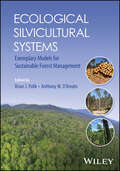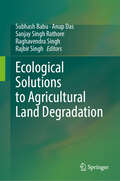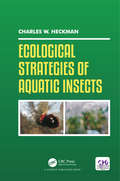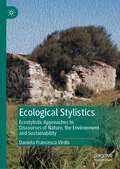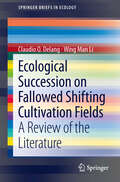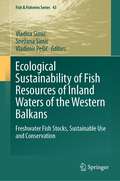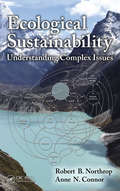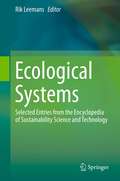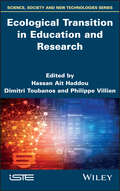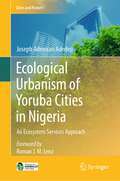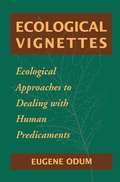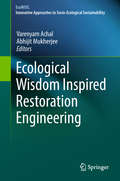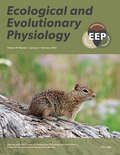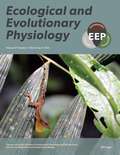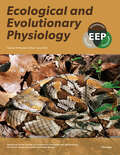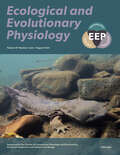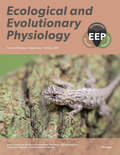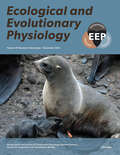- Table View
- List View
Ecological Silvicultural Systems: Exemplary Models for Sustainable Forest Management
by Brian J. Palik Anthony W. D’AmatoECOLOGICAL SILVICULTURAL SYSTEMS Unleash the natural power and adaptability of forests with this cutting-edge guide For generations, silvicultural systems have focused largely on models whose primary objective is the production of timber, leading to drastically simplified forests with reduced ecological richness, diversity, and complexity. Ecological silviculture, by contrast, focuses on producing and maintaining forests with “all their parts”—, that is, with the diversity and flexibility to respond and adapt to global changes. Ecological silviculture seeks to emulate natural development models and sustain healthy forests serving multiple values and goals. Ecological Silvicultural Systems provides a comprehensive introduction to these approaches and their benefits tailored to diverse types of forests, designed for forest management professionals. It provides a series of exemplary models for ecological silviculture and surveys the resulting forest ecosystems. The result is a text that meets the needs of professionals in forestry and natural resource management with an eye towards sustaining healthy forest ecosystems, adapting them to climate change, protecting them from invasive species, and responding to changing market forces. Ecological Silvicultural Systems readers will also find: Detailed treatment of forest ecosystems in North America, Europe, South America, and Australia A broad field of contributors with decades of combined expertise on multiple continents Discussion of pine woodlands; temperate hardwood forests, boreal forests, temperate rainforests, and more Ecological Silvicultural Systems is a useful reference for professional foresters, wildlife habitat managers, restoration ecologists, and undergraduate and graduate students in any of these fields.
Ecological Solutions to Agricultural Land Degradation
by Anup Das Subhash Babu Rajbir Singh Raghavendra Singh Sanjay Singh RathoreThis book provides an overview of the current status of land degradation globally and the different approaches used for its restoration. In addition to the technical aspects, it also delves into the social and economic implications of land restoration, such as in terms of policy planning. Land degradation is a serious threat to agriculture, affecting soil function and productivity. There are up to 6 billion hectares of degraded soil worldwide. It is estimated that 30% of forests, 20% of agricultural land and 10% of rangelands are severely affected by land degradation. The main causes of land degradation are soil erosion, acidification, compaction and salinization, intensive agriculture, overgrazing, poor management of arable land and deforestation. The consequences of such degradation include sand dune expansion and displacement, reduced rainfall, rangeland depletion, wind and rain erosion, and loss of biomass and biological integrity. In 2015, the global goal of achieving land degradation neutrality (LDN) was included in the 2030 Agenda for Sustainable Development as sustainable development goal 15.3. Developing productive soil ecosystems by restoring degraded soils is therefore a future perspective for food security and environmental sustainability. This can be achieved through crop rotation, agroforestry, conservation agriculture, cover crops, terrace farming, ditching, geo-jute, and contour farming and zero tillage. Ecological restoration of farmlands offers an opportunity to reconcile agricultural production with improving ecosystem services. Restoring degraded land through environmentally friendly agroecological approaches has the potential to improve agricultural production and provide healthy ecosystems for organisms. This book is an important resource for students, academics, researchers, national and international agricultural scientists, and soil experts.
Ecological Strategies of Aquatic Insects
by Charles W. HeckmanThis book recounts the habits of many interesting and unusual exceptions to the rule that insects are typically terrestrial forms of life. It examines the different ways that groups of species have developed modes of existence in or on the surface of water, and gives reasons why the gross morphology of insects is not favorable for life in or near bodies of water, such as wings that fail to function after coming into contact with water, rendering them useless.
Ecological Stylistics: Ecostylistic Approaches to Discourses of Nature, the Environment and Sustainability
by Daniela Francesca VirdisThis book reflects the cutting edge in ecostylistic approaches to nature, the environment and sustainability as represented in contemporary non-literary discourse. Firstly, the book presents the ecolinguistic and stylistic terms and theories applied in this ecostylistic analysis (ecosophy, beneficial, ambivalent and destructive discourses; and foregrounding, point of view, metaphor), and reviews the most recent literature in the field of ecostylistics. Secondly, the book examines the occurrences of five marker words (nature, environment, ecosystem, ecology, sustainability) on the websites of five environmental organisations and agencies (Forestry England, Greenpeace International, National Park Service, Navdanya International, World Wide Fund for Nature). The main research purpose of this study is to identify beneficial discourses in the environet and to investigate the beneficial ecostylistic strategies utilised to produce them. Above all, this book reminds us humans that we do not stand apart from nature: we are a part of it. The book will be of interest to scholars of stylistics, ecolinguistics and ecocriticism, as well as scholars of discourse analysis, environmental communication and environmental humanities.
Ecological Succession on Fallowed Shifting Cultivation Fields
by Claudio O. Delang Wing Man LiThe book reviews the literature on the ecological succession of plants on fallowed swiddens in tropical forests. Patterns of ecological succession in tropical forests are insufficiently understood, partly because results are scattered through a large number of case studies reported in academic articles. So far, no publication has attempted to bring these different case studies together to identify common patters and trends. The goal of the book is to review the different case studies, and identify common patterns of ecological succession in fallowed swiddens, as well as to pinpoint the factors that cause ecological succession in some areas to differ from those in other areas. The book is organised in four different sections: forest structure, forest diversity, species composition, and the factors that contribute to differences in forest recovery rates (the number of times the field was burned, the length of fallow period, the type of soil, and the type of forest). This book is an important contribution to tropical forestry and shifting cultivation. Deforestation and forest degradation are the largest sources of CO2, and shifting cultivation is one of the main culprits. For this (and other economic and political) reason governments attempt to curtail shifting cultivation by shortening the years the fields can be left fallow, or outright outlawing the farming practice. Yet, there is insufficient understanding of the processes of ecological succession in fallows, which raises the questions as to whether the policy fulfils its objectives.
Ecological Sustainability of Fish Resources of Inland Waters of the Western Balkans: Freshwater Fish Stocks, Sustainable Use and Conservation (Fish & Fisheries Series #43)
by Vladimir Pešić Vladica Simić Snežana SimićThis book provides a detailed evaluation of the hydro-ecological characteristics of the Western Balkans, an area characterized by still preserved inland waters and fish resources important for the European continent, as well as the biodiversity of inland waters important for the planet Earth. Freshwater ecosystems cover only 1% of the Earth's surface; however, they are a habitat for about 40% of fish species. At the same time, inland fisheries make less than 12% of the world's global fish catch, with 43% coming from low-income and food-deficient countries (Africa, South America, Southeast Asia). In Europe, the Western Balkans have significant fishing waters and fish resources, including the Middle Danube drainage (Sava, Drina, Velika Morava river systems), large ancient lakes (Skadar/Shkodra, Ohrid, Prespa, Dojran), and the Adriatic basin characterized by endemic and commercially important species. However, in contrast to the high fishing potential in a significant part of the Western Balkans, diverse and specific political, economic, and social factors largely had a negative impact on the state of fish resources. This volume is multidisciplinary and provides a sound knowledge base for scientific and practical fisheries. In addition, it may be a valuable guide for managers and conservationists worldwide to adapt methods and procedures for the ecological sustainability of fish resources under specific local, natural, and socio-economic conditions. Finally, the content is a good reference for natural sciences and agriculture students studying fish, fish resources, and fisheries sciences. It would improve their knowledge and perspectives on the challenges of sustainable use and conservation of inland water resources.
Ecological Sustainability: Understanding Complex Issues
by Robert B. Northrop Anne N. ConnorComplex systems is a new field of science studying how parts of a system give rise to the collective behaviors of the system, and how the system interacts with its environment. This book examines the complex systems involved in environmental sustainability, and examines the technologies involved to help mitigate human impacts, such as renewable ene
Ecological Systems
by Rik LeemansEarth is home to an estimated 8 million animal species, 600,000 fungi, 300,000 plants, and an undetermined number of microbial species. Of these animal, fungal, and plant species, an estimated 75% have yet to be identified. Moreover, the interactions between these species and their physical environment are known to an even lesser degree. At the same time, the earth's biota faces the prospect of climate change, which may manifest slowly or extremely rapidly, as well as a human population set to grow by two billion by 2045 from the current seven billion. Given these major ecological changes, we cannot wait for a complete biota data set before assessing, planning, and acting to preserve the ecological balance of the earth. This book provides comprehensive coverage of the scientific and engineering basis of the systems ecology of the earth in 15 detailed, peer-reviewed entries written for a broad audience of undergraduate and graduate students as well as practicing professionals in government, academia, and industry. The methodology presented aims at identifying key interactions and environmental effects, and enabling a systems-level understanding even with our present state of factual knowledge.
Ecological Transition in Education and Research
by Hassan Ait Haddou Dimitri Toubanos Philippe VillienThis book centers on climate change, a pressing issue in the ecological transition, particularly for landscape and architecture schools.The scientific realities and consequences of this phenomenon are becoming increasingly well-known and it is now evident that architecture, urban planning and landscaping all have the potential to mitigate these consequences.Ecological Transition in Education and Research is a multidisciplinary collective work, intended to raise awareness of adaptation and mitigation strategies such as action-research, educational innovations and concrete transition practices that embrace different schools of thought. The overall goal is to promote educational practices and research on climate change.
Ecological Urbanism of Yoruba Cities in Nigeria: An Ecosystem Services Approach (Cities and Nature)
by Joseph Adeniran AdedejiThis book offers in-depth ethnographic analyses of key informants’ interviews on the ecological urbanism and ecosystem services (ES) of selected green infrastructure (GI) in Yoruba cities of Ile-Ife, Ibadan, Osogbo, Lagos, Abeokuta, Akure, Ondo, among others in Southwest Nigeria. It examines the Indigenous Knowledge System (IKS) demonstrated for wellbeing through home gardens by this largest ethno-linguistic group in Nigeria. This is in addition to the ES of Osun Grove UNESCO World Heritage Site, Osogbo; Biological Garden and Park, Akure; Lekki Conservation Centre, Lagos; Adekunle Fajuyi Park, Ado-Ekiti; Muri Okunola Park, Lagos; and some institutional GI including University of Ibadan Botanical Gardens, Ibadan; Federal University of Agriculture Abeokuta Botanical Garden, Abeokuta; and University of Lagos Lagoon Front Resort, Lagos, Nigeria. The study draws on theoretical praxis of Western biophilic ideologies, spirit ontologies of the Global South, and largely, Millennium Ecosystem Assessment (2005) to examine eco-cultural green spaces, home gardens, and English-types of parks and gardens as archetypes of GI in Yoruba traditional urbanism, colonial and post-colonial city planning. The book provides methods of achieving a form of modernized traditionalism as means of translating the IKS into design strategies for eco-cultural cities. The strategies are framework, model, and ethnographic design algorithms that are syntheses of the lived experiences of the key informants.
Ecological Vignettes
by Eugene P OdumFirst Published in 2004. Routledge is an imprint of Taylor & Francis, an informa company.
Ecological Wisdom Inspired Restoration Engineering (EcoWISE)
by Abhijit Mukherjee Varenyam AchalThis book focuses on ecological wisdom inspired restoration engineering through theories, hypotheses, policies, practical understanding, and case studies. Understanding nature’s processes is a prerequisite for the healthy and sustainable functioning of a habitable Earth. As such, the book provides a guide for readers seeking to understand and build sustainable, urban socio-ecological systems using restoration technologies based on wisdom. Motivated by recent rapid advances in restoration engineering, such as the role of green building materials in urban infrastructures, and developing sustainable landscapes to benefit the environment, economy and communities, it is an essential reference on the most promising innovative technologies. It discusses engineering methods and practices in the restoration of soil, water, heritage sites, and other ecosystems, as well as the development and applications of green building materials. It presents a holistic and systematic approach that utilizes natural resources and the concept of ecological wisdom to reap sustainable environmental, economic and social benefits to fulfill the concept of living in harmony with nature. This book is a valuable resource for civil- and environmental engineering researchers as well as organizations engaged in eco-restoration practices.
Ecological Wisdom: Theory and Practice (EcoWISE)
by Bo Yang Robert Fredrick YoungThis book offers an introduction to the theory and practice of ecological wisdom (EW). EW is the integration of robust contemporary science with proven cultural and historical practices to identify long-term, sustainable solutions to problems of environmental management and urban design. The book combines theoretical concepts with specific case studies, illustrating the opportunities for interdisciplinary approaches combining historical experience, cultural context, and contemporary science as effective strategies for addressing complex problems confronting metropolitan and rural environmental and resource management in areas such as land use, water management, materials and building engineering, urban planning, and architecture and design. EW transcends the limitations in these fields of the normative approaches of modernity or traditional wisdom by offering a new, synthetic strategy to address socio-ecological issues. By presenting these ideas both theoretically and through existing case studies, the book provides researchers, practitioners and students with a powerful new perspective in developing long-term, resilient solutions to existing socio-environmental challenges. It is intended mainly for those working or interested in the fields of sustainable environmental and resource management, city and regional planning, architecture and design, civil engineering, landscape architecture, and the philosophy of science, particularly those with an ecological or sustainability focus.
Ecological and Economic Entomology: A Global Synthesis
by Brian FreemanEcological and Economic Entomology is a comprehensive advanced text covering all aspects of the role of insects in natural ecosystems and their impacts on human activity. The book is divided into two sections. The first section begins with an outline of the structure, classification and importance of insects, followed by the geographical aspects of plant distribution and the complex defences plants marshal against herbivorous insects. Insect pests affecting plant roots, stem, leaf, and reproductive systems are covered in a comprehensive review. This section also covers insects that are important in medical and veterinary science, paying particular attention to those that transmit pathogens. The section concludes with the beneficial aspects of insects, especially their use in biological control, but also as soil formers and their importance in forensic science. Autecology (or single-species ecology) and its application to pest management is the focus of the second section of the book. Firstly, some general aspects of autecology are examined, including species abundance, competition and speciation, and relevant genetics. The classic general theories of insect population dynamics are reviewed, followed by chapters on life tables, time series analysis and mathematical models in insect populations. The final chapter reviews the application of autecology to the insect pests of forests, farms and orchards and to the control of insect vectors of diseases of humans and livestock. Particular attention is paid to environmentally friendly methods of pest management and the application of Integrated Pest Management (IPM) techniques. This volume is essential reading for professional entomologists and advanced students of agricultural, medical and veterinary entomology, insect ecology and conservation.
Ecological and Evolutionary Modelling (SpringerBriefs in Ecology)
by Cang Hui Pietro Landi Henintsoa Onivola Minoarivelo Andriamihaja RamanantoaninaEcology studies biodiversity in its variety and complexity. It describes how species distribute and perform in response to environmental changes. Ecological processes and structures are highly complex and adaptive. In order to quantify emerging ecological patterns and investigate their hidden mechanisms, we need to rely on the simplicity of mathematical language. Ecological patterns are emerging structures observed in populations, communities and ecosystems. Elucidating drivers behind ecological patterns can greatly improve our knowledge of how ecosystems assemble, function and respond to change and perturbation. Mathematical ecology has, thus, become an important interdisciplinary research field that can provide answers to complex global issues, such as climate change and biological invasions.The aim of this book is to (i) introduce key concepts in ecology and evolution, (ii) explain classic and recent important mathematical models for investigating ecological and evolutionary dynamics, and (iii) provide real examples in ecology/biology/environmental sciences that have used these models to address relevant issues. Readers are exposed to the key concepts, frameworks, and terminology in the studies of ecology and evolution, which will enable them to ask the correct and relevant research questions, and frame the questions using appropriate mathematical models.
Ecological and Evolutionary Physiology, volume 97 number 1 (January/February 2024)
by Ecological and Evolutionary PhysiologyThis is volume 97 issue 1 of Ecological and Evolutionary Physiology. Ecological and Evolutionary Physiology primarily publishes original research in physiological ecology, ecophysiology, comparative physiology, and evolutionary physiology. Studies at all levels of biological organization from the molecular to the whole organism are welcome, and work that integrates across levels of organization is particularly encouraged. Studies that focus on behavior or morphology are welcome, so long as they include ties to physiology or biochemistry, in addition to having an ecological or evolutionary context. Subdisciplines of interest include nutrition and digestion, salt and water balance, epithelial and membrane transport, gas exchange and transport, acid-base balance, temperature adaptation, energetics, structure and function of macromolecules, chemical coordination and signal transduction, nitrogen metabolism and excretion, locomotion and muscle function, biomechanics, circulation, behavioral, comparative and mechanistic endocrinology, sensory physiology, neural coordination, and ecotoxicology ecoimmunology.
Ecological and Evolutionary Physiology, volume 97 number 2 (March/April 2024)
by Ecological and Evolutionary PhysiologyThis is volume 97 issue 2 of Ecological and Evolutionary Physiology. Ecological and Evolutionary Physiology primarily publishes original research in physiological ecology, ecophysiology, comparative physiology, and evolutionary physiology. Studies at all levels of biological organization from the molecular to the whole organism are welcome, and work that integrates across levels of organization is particularly encouraged. Studies that focus on behavior or morphology are welcome, so long as they include ties to physiology or biochemistry, in addition to having an ecological or evolutionary context. Subdisciplines of interest include nutrition and digestion, salt and water balance, epithelial and membrane transport, gas exchange and transport, acid-base balance, temperature adaptation, energetics, structure and function of macromolecules, chemical coordination and signal transduction, nitrogen metabolism and excretion, locomotion and muscle function, biomechanics, circulation, behavioral, comparative and mechanistic endocrinology, sensory physiology, neural coordination, and ecotoxicology ecoimmunology.
Ecological and Evolutionary Physiology, volume 97 number 3 (May/June 2024)
by Ecological and Evolutionary PhysiologyThis is volume 97 issue 3 of Ecological and Evolutionary Physiology. Ecological and Evolutionary Physiology primarily publishes original research in physiological ecology, ecophysiology, comparative physiology, and evolutionary physiology. Studies at all levels of biological organization from the molecular to the whole organism are welcome, and work that integrates across levels of organization is particularly encouraged. Studies that focus on behavior or morphology are welcome, so long as they include ties to physiology or biochemistry, in addition to having an ecological or evolutionary context. Subdisciplines of interest include nutrition and digestion, salt and water balance, epithelial and membrane transport, gas exchange and transport, acid-base balance, temperature adaptation, energetics, structure and function of macromolecules, chemical coordination and signal transduction, nitrogen metabolism and excretion, locomotion and muscle function, biomechanics, circulation, behavioral, comparative and mechanistic endocrinology, sensory physiology, neural coordination, and ecotoxicology ecoimmunology.
Ecological and Evolutionary Physiology, volume 97 number 4 (July/August 2024)
by Ecological and Evolutionary PhysiologyThis is volume 97 issue 4 of Ecological and Evolutionary Physiology. Ecological and Evolutionary Physiology primarily publishes original research in physiological ecology, ecophysiology, comparative physiology, and evolutionary physiology. Studies at all levels of biological organization from the molecular to the whole organism are welcome, and work that integrates across levels of organization is particularly encouraged. Studies that focus on behavior or morphology are welcome, so long as they include ties to physiology or biochemistry, in addition to having an ecological or evolutionary context. Subdisciplines of interest include nutrition and digestion, salt and water balance, epithelial and membrane transport, gas exchange and transport, acid-base balance, temperature adaptation, energetics, structure and function of macromolecules, chemical coordination and signal transduction, nitrogen metabolism and excretion, locomotion and muscle function, biomechanics, circulation, behavioral, comparative and mechanistic endocrinology, sensory physiology, neural coordination, and ecotoxicology ecoimmunology.
Ecological and Evolutionary Physiology, volume 97 number 5 (September/October 2024)
by Ecological and Evolutionary PhysiologyThis is volume 97 issue 5 of Ecological and Evolutionary Physiology. Ecological and Evolutionary Physiology primarily publishes original research in physiological ecology, ecophysiology, comparative physiology, and evolutionary physiology. Studies at all levels of biological organization from the molecular to the whole organism are welcome, and work that integrates across levels of organization is particularly encouraged. Studies that focus on behavior or morphology are welcome, so long as they include ties to physiology or biochemistry, in addition to having an ecological or evolutionary context. Subdisciplines of interest include nutrition and digestion, salt and water balance, epithelial and membrane transport, gas exchange and transport, acid-base balance, temperature adaptation, energetics, structure and function of macromolecules, chemical coordination and signal transduction, nitrogen metabolism and excretion, locomotion and muscle function, biomechanics, circulation, behavioral, comparative and mechanistic endocrinology, sensory physiology, neural coordination, and ecotoxicology ecoimmunology.
Ecological and Evolutionary Physiology, volume 97 number 6 (November/December 2024)
by Ecological and Evolutionary PhysiologyThis is volume 97 issue 6 of Ecological and Evolutionary Physiology. Ecological and Evolutionary Physiology primarily publishes original research in physiological ecology, ecophysiology, comparative physiology, and evolutionary physiology. Studies at all levels of biological organization from the molecular to the whole organism are welcome, and work that integrates across levels of organization is particularly encouraged. Studies that focus on behavior or morphology are welcome, so long as they include ties to physiology or biochemistry, in addition to having an ecological or evolutionary context. Subdisciplines of interest include nutrition and digestion, salt and water balance, epithelial and membrane transport, gas exchange and transport, acid-base balance, temperature adaptation, energetics, structure and function of macromolecules, chemical coordination and signal transduction, nitrogen metabolism and excretion, locomotion and muscle function, biomechanics, circulation, behavioral, comparative and mechanistic endocrinology, sensory physiology, neural coordination, and ecotoxicology ecoimmunology.
Ecological and Evolutionary Physiology, volume 98 number 1 (January/February 2025)
by Ecological and Evolutionary PhysiologyThis is volume 98 issue 1 of Ecological and Evolutionary Physiology. Ecological and Evolutionary Physiology primarily publishes original research in physiological ecology, ecophysiology, comparative physiology, and evolutionary physiology. Studies at all levels of biological organization from the molecular to the whole organism are welcome, and work that integrates across levels of organization is particularly encouraged. Studies that focus on behavior or morphology are welcome, so long as they include ties to physiology or biochemistry, in addition to having an ecological or evolutionary context. Subdisciplines of interest include nutrition and digestion, salt and water balance, epithelial and membrane transport, gas exchange and transport, acid-base balance, temperature adaptation, energetics, structure and function of macromolecules, chemical coordination and signal transduction, nitrogen metabolism and excretion, locomotion and muscle function, biomechanics, circulation, behavioral, comparative and mechanistic endocrinology, sensory physiology, neural coordination, and ecotoxicology ecoimmunology.
Ecological and Practical Applications for Sustainable Agriculture
by Rana Pratap Singh Kuldeep Bauddh Sanjeev Kumar John KorstadRampant industrialization, urbanization, and population growth have resulted in increased global environmental contamination. The productivity of agricultural soil is drastically deteriorated and requires a high dose of fertilizers to cultivate crops. To ensure food security, farmers are compelled to apply excess chemical fertilizers and insecticides that contaminate soil, air, and water. Heavy loads of chemical fertilizers not only degrade the quality of agricultural land but also pollute water and air. Use of chemical fertilizers also accelerate the release of greenhouse gases like nitrous oxide and methane along with nutrient runoff from the watershed in to lower elevation rivers and lakes, resulting in cultural eutrophication.Farming practices globally in developed, developing, and under-developing countries should utilize and promote sustainable methods through viable combined environmental, social, and economic means that improve rather than harm future generations. This can include use of non-synthetic fertilizers like compost, vermicompost, slow-release fertilizers, farmyard manures, crop rotations that include nitrogen-fixing legumes. Organic fertilizers like compost and vermicompost improve soil properties like texture, porosity, water-holding capacity, organic matter, as well as nutrient availability. The purpose of this book is to document the available alternatives of synthetic fertilizers, their mode of action, efficiency, preparation methodology, practical suggestions for sustainable practices, and needed research focus. The book will cover major disciplines like plant science, environmental science, agricultural science, agricultural biotechnology and microbiology, horticulture, soil science, atmospheric science, agro-forestry, agronomy, and ecology. This book is helpful for farmers, scientists, industrialists, research scholars, masters and graduate students, non-governmental organizations, financial advisers, and policy makers.
Ecological-Economic Modelling for Biodiversity Conservation (Ecology, Biodiversity and Conservation)
by Martin DrechslerEcologists and economists both use models to help develop strategies for biodiversity management. The practical use of disciplinary models, however, can be limited because ecological models tend not to address the socioeconomic dimension of biodiversity management, whereas economic models tend to neglect the ecological dimension. Given these shortcomings of disciplinary models, there is a necessity to combine ecological and economic knowledge into ecological-economic models. Gradually guiding the reader into the field of ecological-economic modelling by introducing mathematical models and their role in general, this book provides an overview on ecological and economic modelling approaches relevant for research in the field of biodiversity conservation. It discusses the advantages of and challenges associated with ecological-economic modelling, together with an overview of useful ways of integration. Although being a book about mathematical modelling, ecological and economic concepts play an equally important role, making it accessible for readers from very different disciplinary backgrounds.
Ecologically Based Weed Management: Concepts, Challenges, and Limitations
by Nicholas E. Korres Ilias S. Travlos Thomas K. GitsopoulosEcologically Based Weed Management Protect crop yields and strengthen ecosystems with this essential guide Research into weed management is an increasingly critical component of both environmental stewardship and food production. The potential cost of weed propagation can be measured in crop yield reductions, under-nourished populations, stymied economies, and more. The propagation of herbicide-resistant weed populations means that purely chemical weed management is no longer viable; food production can now be secured only with an ecological approach to weed control. Ecologically Based Weed Management details such approaches and their potential to manage weeds across a range of agricultural and environmental contexts. It emphasizes the deployment of ecological principles to prevent weed infestations, reduce crop losses, and strengthen ecosystems. In a time when growing population and changing climates are placing enormous pressure on global food production, this approach to weed management has never been more vital. Ecologically Based Weed Management readers will also find: A global team of expert contributors to a multidisciplinary approach Detailed discussion of topics like herbicide limitation, integrated weed management, and more Insights pertinent to agriculture, academia, government, industry, and more Ecologically Based Weed Management is ideal for researchers in agriculture chemistry, weed science, agronomy, ecology, and related fields, as well as for regulators and advanced students.
